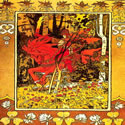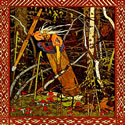Many of the folk songs here and the songs from Snow Maiden are sung in beautiful four part harmonies with many people in each part, that I find incredibly beautiful. But the harmonies convey this wonderful and lively sense of community that seems almost too perfect in the village setting. Music, song, and dance are such vital components to ones identity in a country, and for the community to be able to sing such beautiful songs together creates a very beautiful imagery. The dancing also conveys this imagery by how many people are involve in the dance, playing off of each other. The range of feeling depicted through these songs, especially in the Cossack songs (I’m listening to the “Now the Sun is Hidden” on repeat while writing this) the range goes from incredibly lively with so much spirit, with the whoops, to incredibly beautiful and haunting harmonies. I think its really easy to think of the peasants as being only miserable and unhappy under the yoke of serfdom; however, that does not take away the fact that the peasants had a colorful, lively, and thriving culture amongst themselves. The breadth of self expression seen through their songs shows us that their is another extensive dimension to the Russian serfs.
After being exposed to their songs, dances, and folktales, it has opened my eyes to another side of Russian culture feels thoroughly Russian. The peasants don’t seem to be concerned with their stance in contrast to European culture, and this ignorance allows for a Russian culture to exist without this constant self-comparison to the West.
Looking at the titles of the songs, many seem to be concerned with nature and Russia’s landscape. This admiration is also seen on the second page of Pushkin’s Ruslan and Liudmila, as a form of introduction for the poem. This distinctly Russian folk culture seems to be inextricably tied to Russian lands. The folktales itself seem to come straight out of nature in Pushkin’s introduction: “Across the wood, across the wave,/ a warlock bear’s a warrior’s brave;/ See Baba’s Yaga mortar glide/ All of itself, with her astride.” This imagery than sends us back to the folktales we read and the illustrations drawn up by Ivan Bilibin. Many of the illustration have lavish depictions of Russia’s landscapes.
 :
:
